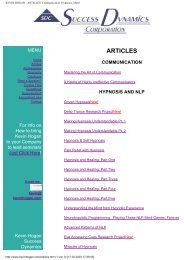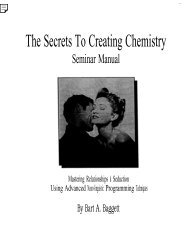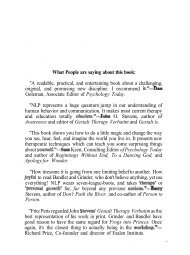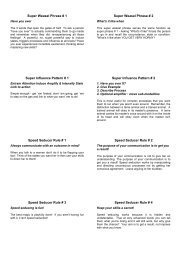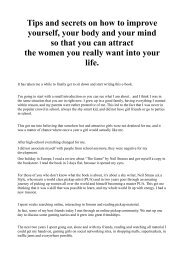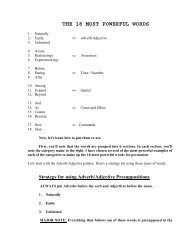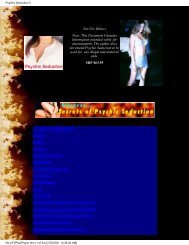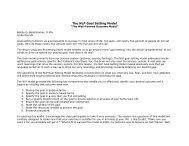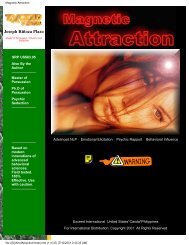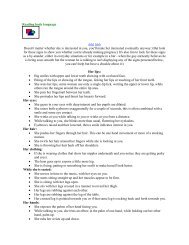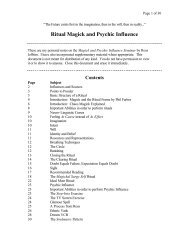A Pragmatic Guide To Communication & Change.pdf - NLP Info Centre
A Pragmatic Guide To Communication & Change.pdf - NLP Info Centre
A Pragmatic Guide To Communication & Change.pdf - NLP Info Centre
- No tags were found...
Create successful ePaper yourself
Turn your PDF publications into a flip-book with our unique Google optimized e-Paper software.
elements. Watch for consistent use of one of these patterns as you continue below.<br />
2. Abstract noun. Say an abstract noun - a nominalization - like "friendship" or<br />
"manifestation," then wait for the nonverbal response. The reponses will usually<br />
be almost immediate.<br />
13. Nonsense syllables. Say 11 nonsense word<br />
126<br />
constructed imaging. Once you know this information, you will find that it remains fairly<br />
constant for any individual. Though accessing patterns seem to remain stable in adults,<br />
children below the age of six or seven do not demonstrate patterns as consistent as<br />
children who are older. This may occur due to the development of hemispheric<br />
dominance which theoretically doesn't develop before that age.<br />
Part B of the mapping process demonstrates how a person is responding to the<br />
environment at that particular moment and may also indicate habitual patterns of<br />
information accessing. With this information, you can discern a person's preferred<br />
representational system and representational system hierarchy. Remember, however, that<br />
these can change depending on such variables as setting, amount of stress the individual<br />
is experiencing, and his or her internal response to you.<br />
Mapping may be used to simply verify the meaning of one small piece of behavior or<br />
information. In the example where Joe exhibited the analog behavior of glancing up and<br />
to the left, the therapist could verify that he was "seeing" an siditic image by simply<br />
asking the appropriate mapping question. Or you can map a person completely prior to a<br />
formal counseling session. Mapping can be done overtly, or the questions can be<br />
embedded in the course of an ordinary interview. Eventually, as you "tune" yourself to the<br />
people around you, you may find that the process of mapping people becomes an<br />
automatic part of your own communicative behavior. Done in this way, almost<br />
unconsciously, it can be a tremendously useful means of both gathering important<br />
information and gaining rapport.<br />
Part A: Mapping the Accessing Cue Schematic<br />
As you ask the questions which follow, pay attention to the person's eyes as well as to<br />
shifts in posture and breathing Sometimes the response is so minimal it is hard to detect.<br />
If you fail to get a satisfactory response, go on to the next question and come back to it<br />
later. The questions given here are only examples. You can be creative and generate<br />
questions of your own, but pay attention to the predicates<br />
127<br />
You use. If they presuppose a representational system which is different from the one you<br />
are testing, the person may be led into the accessing pattern associated with that system.<br />
1. Constructed images. Ask a visual question about the future, like, "What do you<br />
imagine (I, this town, that tree) will look like ten years from now?" This requires the<br />
person to construct an image of something he has not yet experienced.<br />
2. Eidetic images. Ask a visual question about the past like, "What color was your<br />
first car?" or about specific information like, "How many windows are there on<br />
the front of your house?" This calls to mind some previously experienced image.<br />
3. Constructed speech. Ask for a complex verbal response like, "What does it<br />
mean to be `predisposed'?" If you preface this question with the directions, "Just<br />
think about what you would say without answering," you allow for the "rehearsal"<br />
of speech.



